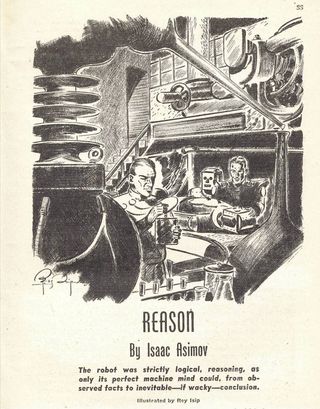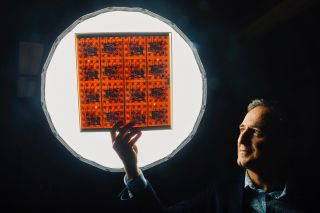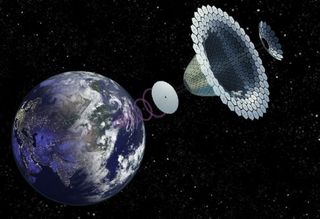The idea of transmitting energy to an energy-hungry Earth from space has been studied for a long time. It was first proposed over 80 years ago in science fiction.
“It was quiet in the officers’ room of Solar Station No. 5 – except for the soft purring of the powerful beam director somewhere far below,” famous author Isaac Asimov wrote in his article “Reason” of April 1941 published in the magazine “Astounding Science Fiction”. “.
Asimov had his characters manning a solar energy harvesting station in space that funneled energy rays to receivers on Earthas well as March. Fast forward to the 21st century, and investigations here on Earth and now in space seem to reinforce this concept. Always, space Solar radiation is considered by some to be a truly distant, out-of-beam technology, an economically dubious concept that makes for good science fiction. Space.com reached out to several technologists to ask what’s new, what’s old, and what’s still missing in terms of transmitting energy to Earth from space.
Related: Scientists send solar energy to Earth from space for the first time
Trio of technologies
Caltech’s Space Solar Power Project (SSPP) is seen by some as a beacon of hope for this technology.
More than a year has passed since the SSPP demonstration technology was launched into the Earth orbit test tank. Once in orbit, the SSPD-1 spacecraft tested a trio of technological innovations designed to help move the space solar power needle closer to full reality. They were:
- DOLCE: An ultralight composite experiment deployable in orbit to present a new packaging and deployment scheme.
- ALBA: 32 different types of photovoltaic (PV) cells to evaluate their resistance to harsh space environments.
- MAPLE: A microwave array for low-orbit power transfer experiment based on custom integrated circuits with precise timing control to selectively focus power on two different receivers to demonstrate wireless power transmission over distance in the space.

Go to the limit
“A lot of things worked, and the ones that worked well, we pushed them until they stopped working,” said Ali Hajimiri, co-director of the Caltech Space Solar Power Project.
Hajimiri focused on integrated circuits and their applications in various disciplines, such as biotechnology, communications and sensing, which cover a wide frequency range from high-speed and radio frequencies to high-precision low-frequency circuits.
Yes, Hajimiri pointed out, there were problems during the SSPD-1 mission, which lasted nine months. “We had a real problem during deployment, but the team fixed the problem. Even during wireless power transfer, we had all kinds of situations. Then we really put the system under pressure towards the end of the mission, to the point where we were actively trying to cause damage.”
Roof construction

On May 22, 2023, the SSPD-1 results literally hit the roof of Caltech’s Gordon and Betty Moore Engineering Laboratory. For just 90 seconds, the spacecraft’s MAPLE hardware transmitted energy to Earth that was harvested in space.
Hajimiri is quick to explain that the level of energy received at roof level was ultra-low. It was mostly about detection, he said, but the real problem is considering the modest amount of energy received as a small step for space solar energy.
The SSPD-1 will soon be decommissioned and left to embark on a destructive dive into the earth’s atmosphere.
The project’s attention now turns to solving problems such as scaling, the possibility of autonomous deployment and the development of lighter structures.
Unknown unknowns
“There are a lot of ‘unknowns’ that still need to be resolved,” Hajimiri said. In this phase of the work, the team is investigating low-cost fabric-like die manufacturing processes. Furthermore, time synchronization is quite difficult, especially on a flexible, flexible structure floating in space.
“We’ve developed new ways of thinking about this problem,” Hajimiri added, “ways that allow a network to determine its own shape and make corrections to it using its electronics.”
Even with SSPD-1’s “goodbye and see you soon” status, many invaluable milestones have been achieved, Hajimiri said. “The biggest challenge is to raise awareness and clearly demonstrate that what we have done is real.”
Scalable solution

There is no clean, firm, dispatchable energy technology other than space-based solar power (SBSP), according to Troy, Michigan-based Virtus Solis Technologies Inc.
John Bucknell is the CEO and founder of the group. “Those of us who have compared all viable energy technologies know that a scalable solution must be low complexity, low mineral intensity, mass manufacturable, and capable of delivering firm, secure, low-cost electrical power, as fossil fuels last did it 200 years,” he said.
Bucknell and his colleagues are building an SBSP system that meets all of these criteria: a constellation of 16 arrays in space that each produce 20 gigawatts of power. Collectively, 320 gigawatts can be delivered anywhere on the planet, he said, a scalable system to become much larger.
“With 50 percent year-over-year capacity growth, SBSP could reach 100 terawatts of production in 30 years and meet the needs of a planet of 10 billion people,” Bucknell said.
Disconnect
“There is still a disconnect between academic studies and studies of aerospace manufacturing costs and what private industry can achieve,” Bucknell believes. “As a result, our projection of $200 million to complete research and development and put a working pilot plant into orbit seems incredible.”
For Bucknell’s money, and for investors as well, it’s the energy industry that needs to hear and understand these options, he suggested, rather than the space industry.
“SBSP still seems like science fiction because they don’t know that the underlying technologies have all matured and all it took was a commercial space launch to make this happen. Virtus Solis was the first to “integrate around this opportunity,” Bucknell said, “designed to meet a cost target to address the global energy market.
Investors want to make sure there is no risk to earnings, Bucknell observed. “An orbital demonstration means you have a real product, so the remaining risk of on-orbit assembly and power transmission has been demonstrated and the product can then evolve.”
Standing room only
John Mankins, of Artemis Innovation Management Solutions in Santa Maria, California, is a leader in promoting the harnessing of solar energy from space.
Mankins participated in an international conference in April on space solar energy hosted by the European Space Agency (ESA) and the British Space Agency at the Royal Aeronautical Society in London.
“It was standing room only,” Mankins recalls. “Almost none of the 200 people were regular players, and that was a huge change,” whether it was Chinese researchers working on space power plant technology or the European SOLARIS initiative. Work is underway in the United Kingdom, as well as progressive research into electric drivetrains in Japan and other countries, he said.
Reusable preparation
Mankins said the foundation for power radiation has been laid many times by field experiments. “For me, the power transmission function was demonstrated decades ago,” he said, “and now the real problem is how to make very large systems.”
For any type of megaproject in space, “the most visible obstacle to space solar power appears to be about to fall,” Mankins advised, namely reusable, low-cost launch vehicles.
The reusable rockets were launched by SpaceX and its Falcon class boosters and now the enormous Spatialship flight program. In the same way, Blue originThe New Glenn launcher approaches its first flight. Other countries are also seeking to prepare for reuse in the booster sector, such as ESA and China.
Power on
However, there is work to be done in the years to come.
Looking to the future, Mankins said systems-level demonstrations can solve problems like finding the right design or determining how far technologies can scale and at what cost. It’s also critical that spacecraft engineers study what’s happening rapidly in robotics here on Earth and apply it to construction in space.
Additionally, the power transmitted from space must go beyond Caltech’s nanowatts per square centimeter experiment and reach microwatts per square centimeter, Mankins advised.
“But in 2-3 years, a thousand times more power. There will be incredible progress,” predicts Mankins, “then the cows will come out of the barn.”